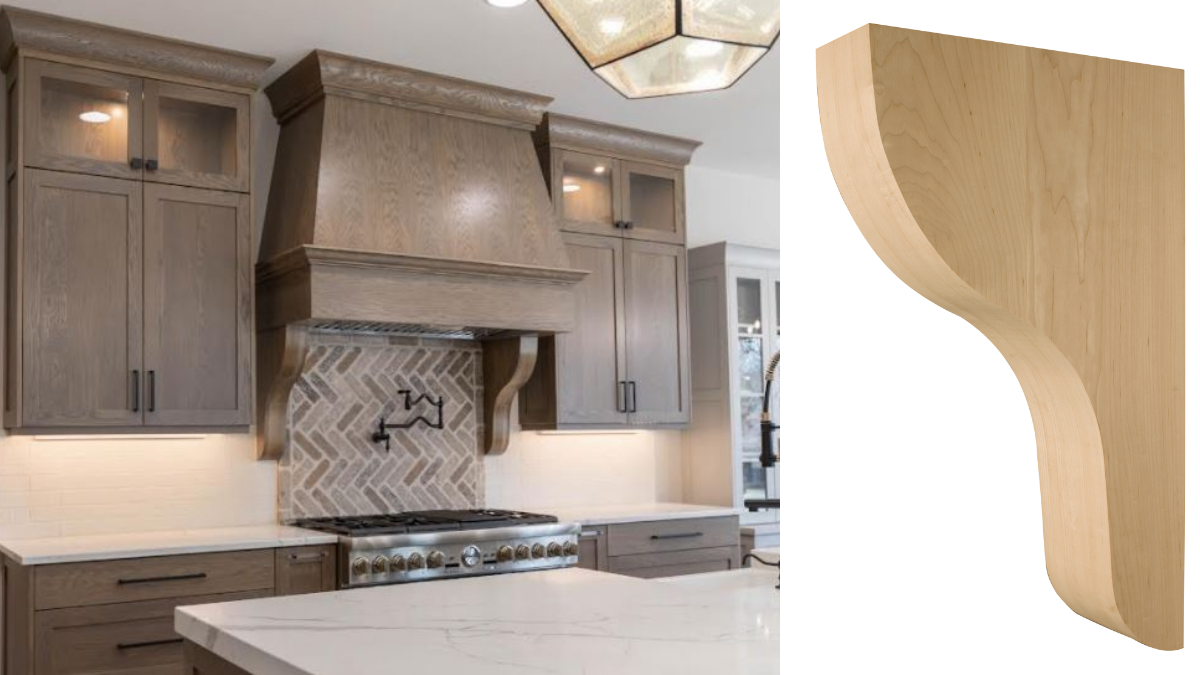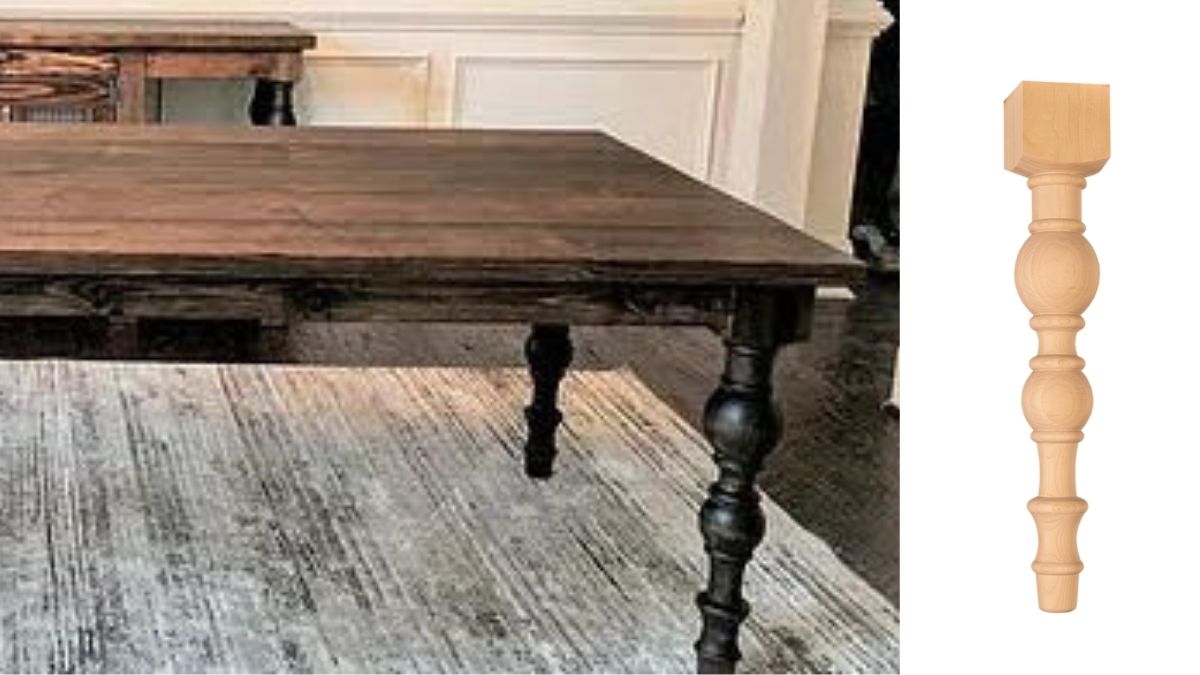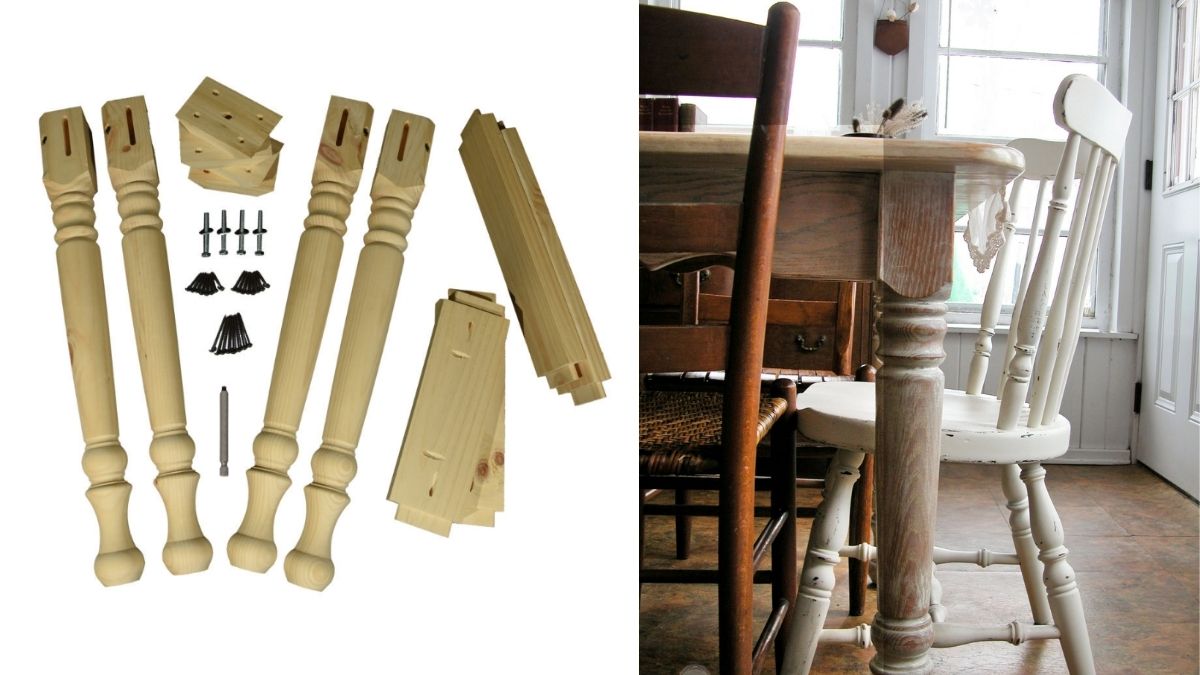Updated for 2023! There are a large number of interior design styles, some more popular or well-known than others. In this blog post, we’re going to dive into quite a few options, including some new options seeing a rise in popularity for 2023! We’ll also look at various products we offer that align with those styles to help you further nail down the perfect look for your home.
Let’s get started!
Traditional

This is one of the most well-known design styles out there. Traditional design is inspired by 18th and 19th century England and France, specifically in regards to popular furniture choices in Victorian England. Traditional designs often include ornate detailing in the furniture and architectural elements, such as Queen Anne legs and ball & claw feet, as well as designs like acanthus leaves and grapes. Wood is often stained very dark or painted very light depending on the use.
Moulding can be very simple, like our picture frame mouldings, or very ornate, like our acanthus leaf mouldings. Crown moulding and baseboards are common, as are elements like wainscoting or chair rail.
One hallmark of traditional design is consistency. That’s why we offer a large selection of our legs in varying heights, including coffee, end, chair, dining, and island height. We also offer designs like acanthus leaves and scrollwork that can be seen across a number of our products, from island legs and corbels to moulding and more.
In the kitchen above, there are seven different Osborne products used in various applications throughout the space. You can read more about each of those products and how they’re used in our how-to guide on using Osborne components in a kitchen build.
Here’s a selection of our products that fit the Traditional design:
Transitional

Transitional is considered one of the most popular styles in the design world, and for good reason. It’s a nice middle ground between the ornate and elegant details of traditional and the clean and sleek elements of contemporary designs. In transitional designs, the furniture often makes the statement rather than the accessories. Hallmarks of transitional furniture includes a combination of old-world and new-world. Wood elements are often stained dark or painted light, and curved furniture is common.
This style also mixes masculine and feminine in both the furniture and decor elements, leading to combinations like plain picture frame moulding with tables featuring ornately turned legs, or Victorian style coffee and end tables mixed with contemporary sofas.
In transitional design, colors are usually light and neutral, aiming to inspire a clean, serene atmosphere. This leaves plenty of room for texture, such as the reeded half legs and the eye-catching backsplash in the photo above.
Here’s a selection of our products that fit the Transitional design:
Contemporary

Contemporary refers to anything in the present moment, and Contemporary design is just that: always present and always evolving. Similar to other design styles on this list, it borrows from other styles to create its own unique look.
Often sleek and simple, Contemporary design features clean lines and open layouts mixed with detailed moldings, a mixture of materials (like metal, glass, and acrylic), and neutral palettes with intentional pops of color. Patterns are replaced with a deliberate use of texture, and light woods are preferred over dark.
Similar to Minimalism (below), Contemporary design tends to showcase the negative space created in the design, and focuses on color and shape, as well. Contemporary furniture tends to be curvier rather than the straight, strong lines preferred in Minimalism, and Contemporary plays with color more than Minimalism does.
Contemporary design really stands out against Minimalism in its use of decor and accessories. Artistic elements are often incorporated into lamps, vases, wall art, and much more. Some Contemporary homes feature abstract paintings, sculptures, and other forms of artwork, as well.
Here’s a selection of our products that fit the Contemporary design:
Minimalist

Minimalist design is clean, light, and open, embracing the negative space created and intentionally using it as its own design element. Minimalism typically incorporates neutral colors, such as white, light grey, and taupe. If color is used, it’s often a single primary color added as an accent color, such as the navy blue used on the island and a section of cabinetry in the kitchen above. Rich textures are also preferred, like the woven basket and rug.
Wood elements are often painted to fit the color scheme, though a light-stained floor or carefully-planned piece of furniture can add some texture to a neutral-colored minimalist living room. Furniture is modern, sleek, and sometimes very simple, with straight, strong lines, and metal pieces often playing a large role in the room’s decor.
When it comes to standard design elements like corbels or crown molding, these elements are often not found in minimalist homes, and if they are, they’ve been drastically simplified or skillfully hidden. Additionally, when it comes to storage space, there often isn’t much to go around, so storage is built into furniture, such as in the form of a coffee table with a lifting top that you can store blankets and other necessities in.
Here’s a selection of our products that fit the Minimalist design:
Industrial

Industrial design takes much of its inspiration from factories and warehouses. When factories would close down at the end of the second industrial revolution, people would move into those abandoned factories and repurpose them into apartment buildings, lofts, and other living quarters. These buildings often had exposed brick walls, pipes, or other architectural elements that new homeowners would work around or work with instead of trying to cover up.
Industrial is a very masculine design style, often using elements like vintage furniture and decor and a combination of wood and metal on the same furniture pieces to bring a room together. Weathered wood is also popular as it fits with the aged, rough appearance.
Kitchen islands are hugely popular in Industrial design, as well. These islands further help separate spaces by providing a defined kitchen area. These islands are also often paired with bar stools and popular Edison lighting or overhead racks for hanging pots and pans.
Here’s a selection of our products that fit the Industrial design:
Mid-Century Modern

Mid-Century Modern design began in post-war America in the 1950s. The design industry began trying to break away from the stuffier traditional designs and move toward the modern era. It can be difficult to define, as it’s usually used in reference to architecture, furniture, and graphic design all in one. However, there are several hallmarks of Mid-Century Modern that can make it easier to define.
One such hallmark is a reemergence of wood, especially warm tones. Rich woods like teak and walnut are popular for this design and used often in all sorts of furniture, from coffee tables and TV stands to bookshelves and dining room sets. Mid-century modern table legs might feature cylindrical tapers or hairpin legs.
Popular colors in the style include mustard yellow and avocado green, along with other kitchy colors like oranges and muted reds. Furniture includes various elements such as round tapered legs (both vertical and slightly slanted), warm wood stains, and abstract prints and patterns. Additionally, Mid-Century Modern styles also take advantage of sliding glass doors and large windows.
Here’s a selection of our products that fit the Mid-Century Modern design:
Farmhouse

Farmhouse design is known for its warmth and simplicity. It’s rooted in rustic country charm and mixes in elements of other designs, such as contemporary and industrial. Joanna Gaines of Fixer Upper fame has almost single-handedly made this style as popular as it is right now.
Farmhouse design is most often characterized by an abundance of white in the cabinets, walls, and furniture, though other light tones such as grey or ivory are also used. These are mixed with farmhouse elements, such as the traditional farmhouse style dining table, shiplap, large overhead beams, stone fireplaces, and accent walls. Benches paired with dining tables are popular, as is giving antique furniture a new life with fresh stain, or giving it a distressed look with paint and new upholstery.
Common architectural elements like corbels and crown molding are popular, though usually simple and often painted. Butcher block counters and table tops are common, as are reclaimed wood table tops. These are often either painted or simply given a clear coat and left with their natural color, depending on the color palette in the house and the condition of the reclaimed wood.
Here’s a selection of our products that fit the Farmhouse design:
Rustic

Rustic design can best be described as raw, rugged, and unrefined. It uses natural elements like wood and stone, focusing on things like large exposed ceiling beams and fireplaces that become the focal point of the room.
Wood, especially reclaimed wood, is ideal and used liberally throughout the home. Pine and oak are most common, while cherry, alder, and hickory are also popular. Most importantly, wood is rarely if ever painted, opting instead for warm, medium to dark stains. Wood accents are used in the window panes, staircases, exposed beams around doorways and in the ceilings, and in many other areas. (Here at Osborne, we offer a weathered wood service for pine and red oak only that gives your brand new wood that reclaimed look.)
Wrought iron is a popular accent in Rustic looks, especially in smaller details like door knobs, cast iron bands or strips, and in lighting fixtures. Also popular are various natural accents, such as deer antlers, multiple kinds of stone, hair-on leather rugs, and much more.
Here’s a selection of our products that fit the Rustic design:
Art Deco

There aren’t many who have never heard of the Art Deco style of interior design. Short for Arts Decoratifs, Art Deco is characterized by rich colors, bold geometry, and decadent details. The iconic style began in the early twentieth century in France, then made its way to the US in the 1920s. Now it’s beginning to see a resurgence in popularity.
Popular elements of Art Deco include sunburst motifs, zigzags, chevrons, and stepped patterns, as well as wood products with a dark stain and a high-shine finish. Notably absent from Art Deco are more traditional floral or plaid patterns, as this style favors geometric and blocky styles, especially in wall hangings and wallpaper. Also prominent in this style is various metals, such as chrome, brass, and silver. Mirrors and mirror finish items are also popular, such as our Mirror Mission Bun Foot (part #4182) included in our selection below.
This trend’s resurgence means a more modern take on the classic Art Deco elements. That may mean florals mixed with glam mirrored pieces like in the photo above, or it may mean an artful mix of geometric and modern furniture in a room painted a single bold color instead.
Here’s a selection of our products that fit the Art Deco design:
Japandi

Japandi is a relatively new design style that combines the Japanese idea of wabi sabi–defined as “a world view centered on the acceptance of transience and imperfection”–and the Scandinavian idea of hygge, which embodies coziness and “comfortable conviviality”. Think of it like a cozy, almost rustic minimalism. Japandi began to grow in popularity in 2021, and with its core idea being warmth and imperfection, this trend may be here to stay.
At their core, both Japanese and Scandinavian style are very similar, sharing several elements: the importance of natural materials, clean lines, minimal clutter, and practical design. They differ in things like color choice (Japanese tends to favor dark while Scandinavian favors light), but those differences allow them to play off of each other to create a unique and very 2020s style.
Since both of these styles also share aspects of minimalism, many of the design elements will be the same. Functional & simple furniture with little to no ornamentation is expected, often in light stained wood tones popular in Scandinavian design which contrast against darker colors like black or navy blue that are popular in Japanese styles. Natural materials like stone or rattan furniture are common alongside richly textured items, such as handmade pottery or a woven rug. Sustainable materials like bamboo are also popular choices, as are rich metal accents in furniture, lighting, and hardware.
Here’s a selection of our products that fit the Japandi design:
Maximalism

Maximalism is another design style that’s enjoying a surge in popularity right now, likely in response to seeing so much minimalism over the past several years. It’s also a very unique style in that, while it does pull elements from other design styles, it’s not set in a certain style in the way that Japandi is very much a minimalist style.
Maximalism focuses more on telling a story, specifically speaking about the person or people who live in the home. For some, that may look more modern, with hints of mid-century furniture, modern art, and simple architectural elements like in the photo above. For others, that may look more traditional, with antique or refinished furniture, thrifted decor, and more ornate architectural elements.
Depending on whether you prefer a more modern or traditional base, there are many different directions in which you could go. The primary focus when designing for a maximalist style is to be very intentional and curated in the elements you bring together. To help with that, we have a number of different product collections available on our website, including classical, mid-century, and contemporary options, to better help you design the perfect space for you.
For more inspiration and ideas, check us out on Pinterest! We have a board dedicated to each of these design styles with carefully curated pins to help inspire you.
Have questions regarding a particular product? Have a design in mind for a product, but no clue how to make it? Give us a call! Our friendly customer service team is happy to answer any questions you have. We also offer custom products, and you can either fill out our quote request form, or give us a call at 800.849.8876.










































































































